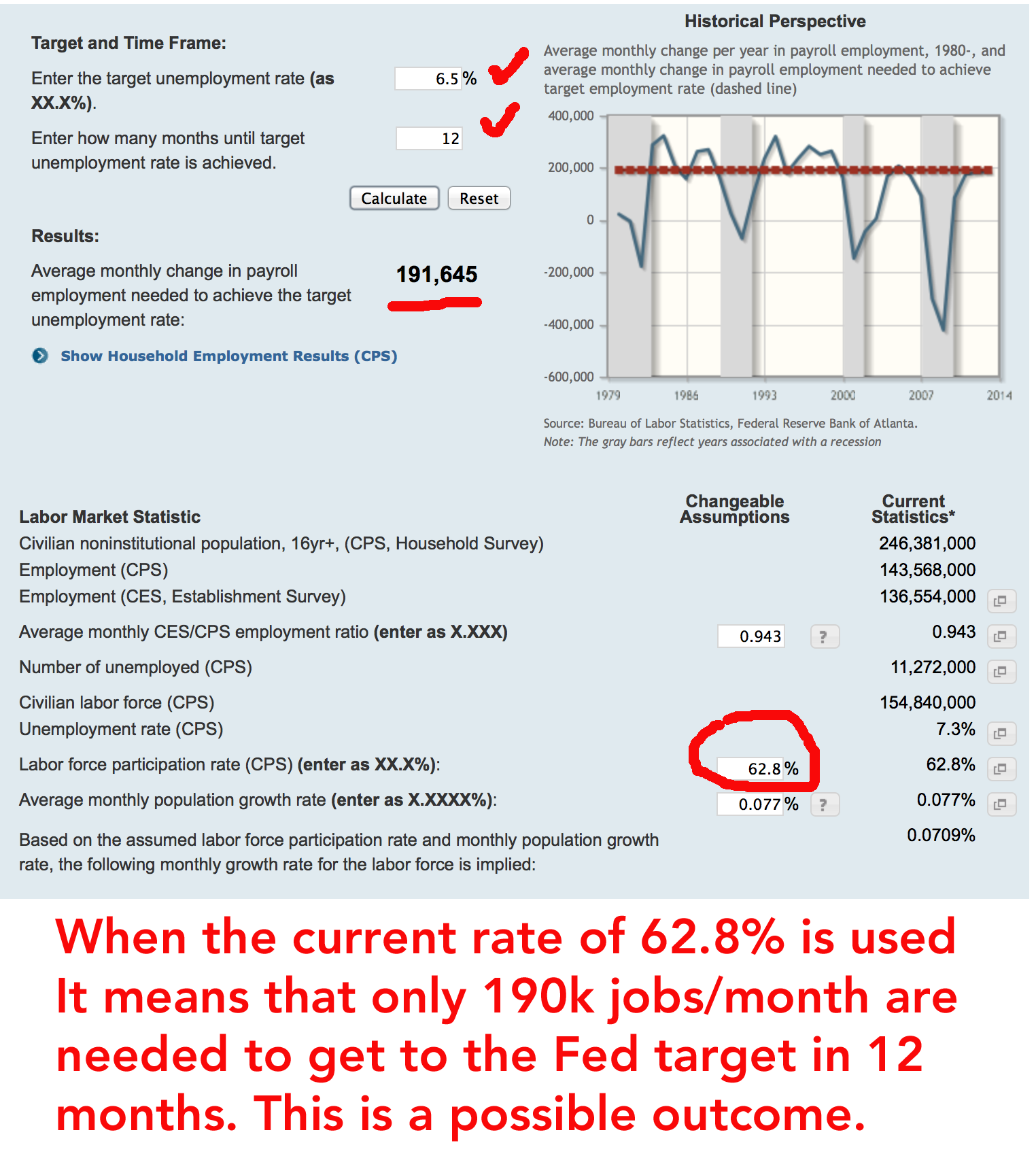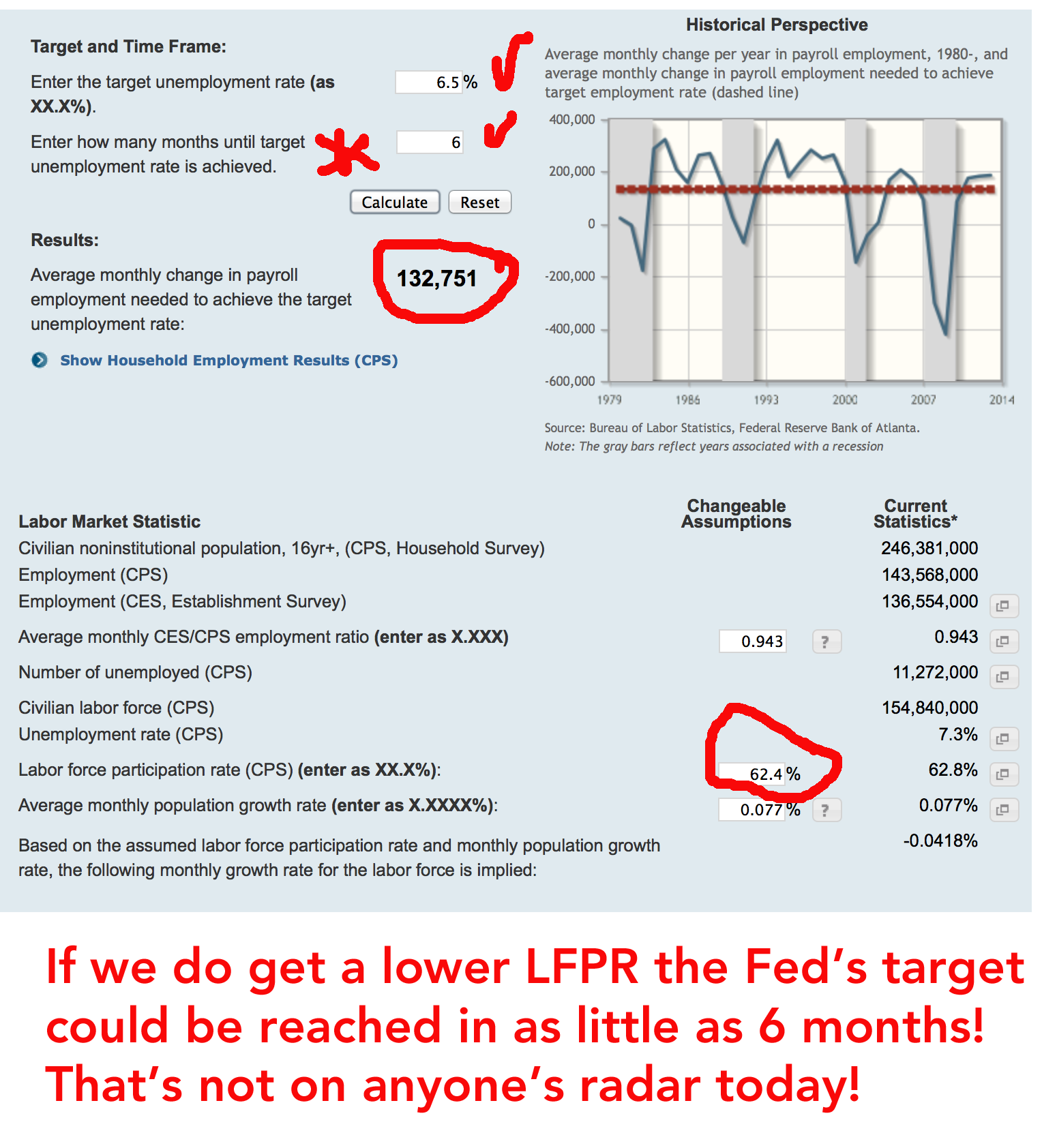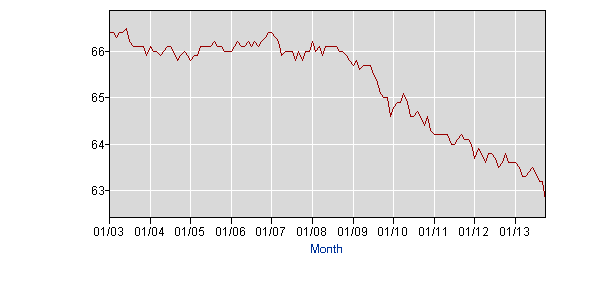I was blown out by the Labor Force Participation Rate (LFPR) data released Friday. Down 4 tics to 62.8%. That sounds like no big deal, but it is. Either there is something out of whack with the data, and it will be revised, or there will have to be some serious rethinking by the folks who develop long-term economic models, and also at the Federal Reserve.
Consider the short term consequences. The Fed has hung its monetary hat on an unemployment rate of 6.5%. We have been told, time and again, that if the magic number of 6.5% unemployment is reached, the madness of US monetary policy will be relaxed. Should the LFPR continue to drop, the hurdle rate for changes to Fed policy will come sooner than is anticipated.
The Atlanta Fed has an interactive tool that looks at this (Link). It takes into consideration the variables of the unemployment picture and produces a report of how many jobs are needed per month over a given period, to achieve the 6.5% level. A few examples:



As you can see, the Fed’s target can be reached in the next 12 months if the LFPR falls a bit further. I’m quite certain that should things unfold like this the new head of the Fed, Janet Yellen, will change the ‘rules’ and ignore the 6.5% target and continue along with ZIRP and QE. But if she does that, it will be at her (and our) risk.
Then you have the long-term side of declining LFPR. A low LFPR means that there are less workers earning taxable income. That translates into less government revenue. Payroll taxes (Social Security and Medicare) total 15% of wages. For an average worker making $40,000 a year that comes to $6,000. When the LFPR drops by 0.1% it means that there will be 180,000 less workers filling the tax bucket. The .1% drop translates into $1Bn less in tax revenue. The .4% drop in October therefore means $4Bn in lost revenue. It adds up quick.
All of the models used to forecast future federal deficits rely on a much higher LFPR assumption than today’s reality. The Congressional Budget Office did a long term forecast of LFPR. The CBO hung its hat on a LFPR that is higher than 62.8%, meaning the forecasts of future tax receipts (and subsequent deficits) were wrong.
The 64.4% assumption the CBO used versus the 62.8% that exists today translates into 4m less workers contributing to the system, and those 4m workers (and their employers) will not pay $25B in payroll taxes. A 1/4 trillion adjustment over ten-years just due to a revision of the LFPR. That’s real money.
I’ve looked at long-term forecasts for LFPR from CBO and BLS. They all have the participation rate dropping over time, but they do not have the drop occurring in the present. What if the ‘New Normal’ is a participation rate that hangs in the low 60% level for the next decade? It translates into much larger deficits at the Federal and State levels. It means that there will be less consumption as there will be no paychecks, and that means a much lower rate of growth of GDP.
So either the LFPR turns around and starts heading higher very soon (and stays higher for another decade), or the USA is in for a prolonged period of sub par growth and very high annual deficits.
Consider this chart of LFPR. The drop is accelerating. What are the odds that the long-term trend towards lower participation is going to turn around soon? I would say, “Not high”. 
Note: This analysis only looks at the consequences to payroll taxes from a drop in LFPR. There is is also lost revenue from State and Federal income taxes, and there is the broader drop in consumption to add into the mix. All in, the drop in participation is a very big deal.
- English (UK)
- English (India)
- English (Canada)
- English (Australia)
- English (South Africa)
- English (Philippines)
- English (Nigeria)
- Deutsch
- Español (España)
- Español (México)
- Français
- Italiano
- Nederlands
- Português (Portugal)
- Polski
- Português (Brasil)
- Русский
- Türkçe
- العربية
- Ελληνικά
- Svenska
- Suomi
- עברית
- 日本語
- 한국어
- 简体中文
- 繁體中文
- Bahasa Indonesia
- Bahasa Melayu
- ไทย
- Tiếng Việt
- हिंदी
On The Labor Force Participation Rate: A Siginficant Move Lower
Published 11/10/2013, 05:50 AM
Updated 07/09/2023, 06:31 AM
On The Labor Force Participation Rate: A Siginficant Move Lower
3rd party Ad. Not an offer or recommendation by Investing.com. See disclosure here or
remove ads
.
Latest comments
Install Our App
Risk Disclosure: Trading in financial instruments and/or cryptocurrencies involves high risks including the risk of losing some, or all, of your investment amount, and may not be suitable for all investors. Prices of cryptocurrencies are extremely volatile and may be affected by external factors such as financial, regulatory or political events. Trading on margin increases the financial risks.
Before deciding to trade in financial instrument or cryptocurrencies you should be fully informed of the risks and costs associated with trading the financial markets, carefully consider your investment objectives, level of experience, and risk appetite, and seek professional advice where needed.
Fusion Media would like to remind you that the data contained in this website is not necessarily real-time nor accurate. The data and prices on the website are not necessarily provided by any market or exchange, but may be provided by market makers, and so prices may not be accurate and may differ from the actual price at any given market, meaning prices are indicative and not appropriate for trading purposes. Fusion Media and any provider of the data contained in this website will not accept liability for any loss or damage as a result of your trading, or your reliance on the information contained within this website.
It is prohibited to use, store, reproduce, display, modify, transmit or distribute the data contained in this website without the explicit prior written permission of Fusion Media and/or the data provider. All intellectual property rights are reserved by the providers and/or the exchange providing the data contained in this website.
Fusion Media may be compensated by the advertisers that appear on the website, based on your interaction with the advertisements or advertisers.
Before deciding to trade in financial instrument or cryptocurrencies you should be fully informed of the risks and costs associated with trading the financial markets, carefully consider your investment objectives, level of experience, and risk appetite, and seek professional advice where needed.
Fusion Media would like to remind you that the data contained in this website is not necessarily real-time nor accurate. The data and prices on the website are not necessarily provided by any market or exchange, but may be provided by market makers, and so prices may not be accurate and may differ from the actual price at any given market, meaning prices are indicative and not appropriate for trading purposes. Fusion Media and any provider of the data contained in this website will not accept liability for any loss or damage as a result of your trading, or your reliance on the information contained within this website.
It is prohibited to use, store, reproduce, display, modify, transmit or distribute the data contained in this website without the explicit prior written permission of Fusion Media and/or the data provider. All intellectual property rights are reserved by the providers and/or the exchange providing the data contained in this website.
Fusion Media may be compensated by the advertisers that appear on the website, based on your interaction with the advertisements or advertisers.
© 2007-2024 - Fusion Media Limited. All Rights Reserved.